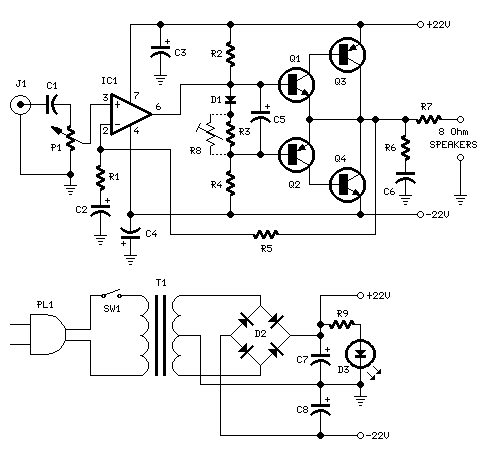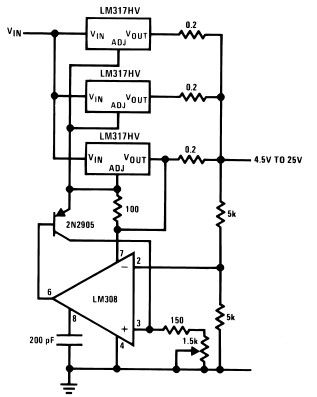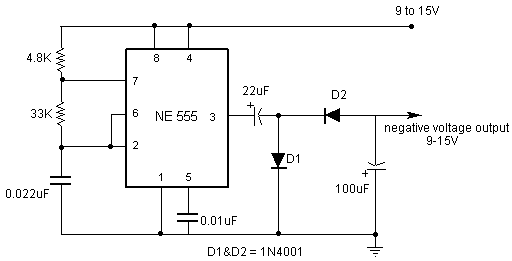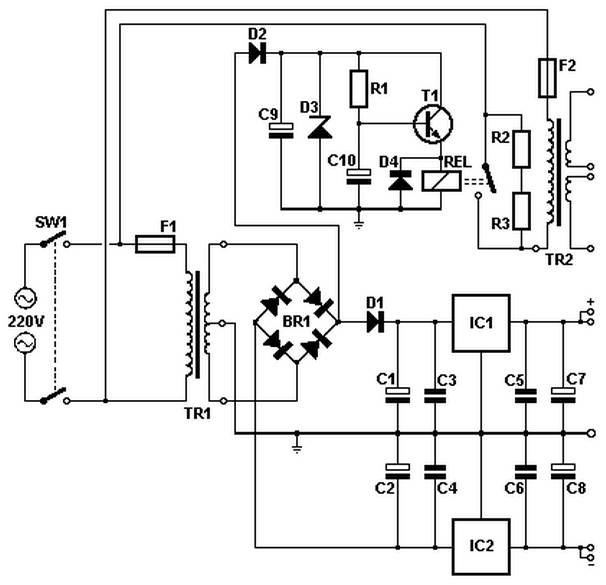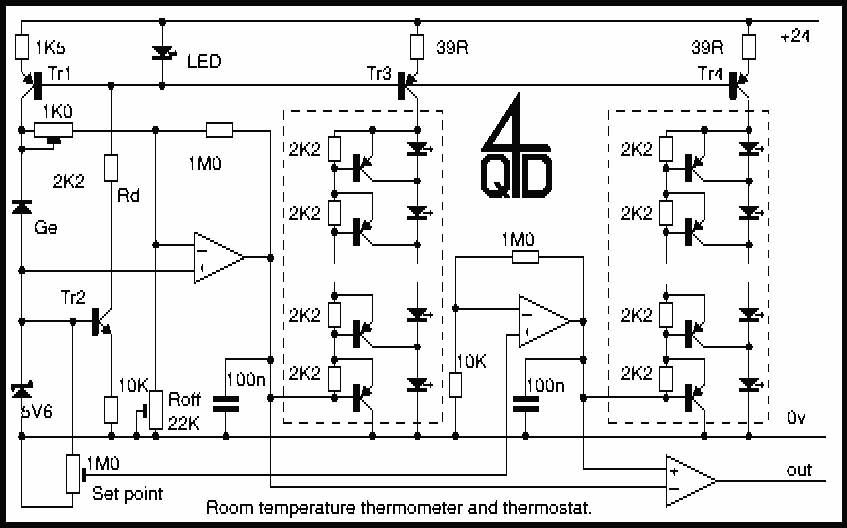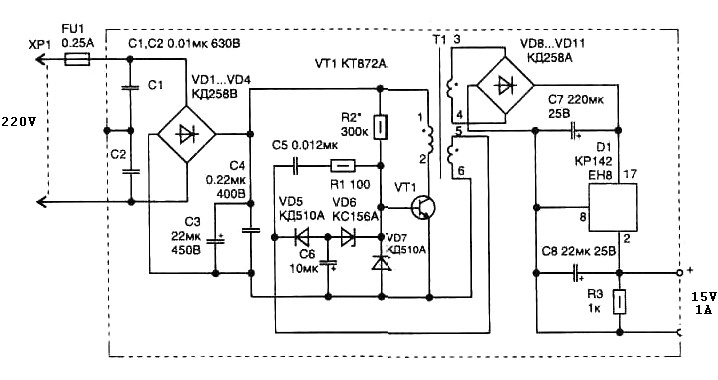
Audio Power Meter
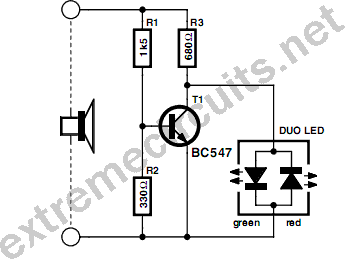
This circuit indicates the power level delivered to a loudspeaker. A dual-color LED displays green at approximately 1 watt, orange at 1.5 watts, and bright red at levels exceeding 3 watts. The circuit is connected in parallel with the loudspeaker connections and is powered by the audio signal. The additional load represented is 470 Ohms (R1//R3), which is manageable for any amplifier. During the positive half cycle of the output signal, the green LED in the dual-color LED illuminates if the voltage is sufficiently high. At higher output voltages, transistor T1 (controlled by the voltage divider R2/R1) begins to conduct, causing the green LED to extinguish. In the negative half cycle, the red LED is activated through R3 when the voltage reaches a certain threshold. In the transition region, where T1 increasingly conducts and reduces the brightness of the green LED, the combination of red and green results in an orange color from the dual-LED. By selecting appropriate resistor values, the power levels can be adjusted accordingly. The specified values are intended for typical living room use. Users may be surprised at how high the amplifier volume must be before the LEDs activate. The resistors can be 0.25 W types, assuming the amplifier does not exceed 40 W of continuous power. Exceeding this power may also affect the transistor's performance, so caution is advised. Since T1 operates in saturation, the current gain (Hfe) is not critical, allowing for the use of any similar transistor type. The specified power levels are applicable for 4-Ohm speakers, while for 8-Ohm speakers, all resistor values must be halved.
This circuit serves as a visual power indicator for loudspeakers, effectively utilizing a dual-color LED to represent varying power levels. The design incorporates a simple yet effective voltage divider and transistor configuration to achieve the desired functionality. The dual-color LED operates based on the output signal from the amplifier, providing real-time feedback on the power being delivered to the loudspeaker.
The circuit is structured with R1 and R3 forming a parallel combination, resulting in a total resistance of 470 Ohms. This value is critical as it ensures that the additional load does not adversely affect the amplifier's performance. The LED's color indication is a direct consequence of the voltage levels present during different cycles of the audio signal.
During the positive half cycle, if the voltage surpasses the activation threshold, the green LED lights up. As the output voltage increases, T1 is triggered to conduct, leading to the green LED turning off and the transition to orange as the red LED begins to illuminate during the negative half cycle. The transition region is particularly interesting as it provides a smooth shift in color, indicating that the power is approaching a critical level.
The choice of resistor values plays a vital role in calibrating the circuit for specific applications. The provided values are designed for typical home audio setups, allowing users to gauge their amplifier's output effectively. The circuit's robustness is enhanced by the use of standard 0.25 W resistors, ensuring reliability within the specified power limits.
It is essential to note that the power levels indicated by this circuit are tailored for 4-Ohm speakers. Users employing 8-Ohm speakers must adjust the resistor values accordingly to maintain accuracy in power indication. This circuit exemplifies a straightforward yet effective approach to monitoring audio power levels, providing users with an intuitive visual representation of their amplifier's output.This simple circuit indicates the amount of power that goes to a loudspeaker. The dual-color LED shows green at an applied power level of about 1 watt. At 1. 5 watts it glows orange and above 3 watts it is bright red. The circuit is connected in parallel with the loudspeaker connections and is powered from the audio signal. The additional load that this represents is 470 Ohm (R1//R3) will not be a problem for any amplifier. During the positive half cycle of the output signal the green LED in the dual-color LED will be turned on, provided the voltage is sufficiently high. At higher output voltages, T1 (depending on the voltage divider R2/R1) will begin to conduct and the green LED will go out.
During the negative half cycle the red LED is driven via R3 and will turn on when the voltage is high enough. In the transition region (where T1 conducts more and more and throttles` the green LED as a result) the combination of red/green gives the orange colour of the dual-LED.
By choosing appropriate values for the resistors the power levels can be adjusted to suit. The values selected here are for typical living room use. You will be surprised at how loud you have to turn your amplifier up before you get the LEDs to go! The resistors can be 0. 25 W types, provided the amplifier does not deliver more than 40 W continuously. Above this power the transistor will not be that happy either, so watch out for that too. Because T1 is used in saturation, the gain (Hfe) is not at all important and any similar type can be used. The power levels mentioned are valid for 4-Ohm speakers. For 8-Ohm speakers all the resistor values have to be divided by two. 🔗 External reference
This circuit serves as a visual power indicator for loudspeakers, effectively utilizing a dual-color LED to represent varying power levels. The design incorporates a simple yet effective voltage divider and transistor configuration to achieve the desired functionality. The dual-color LED operates based on the output signal from the amplifier, providing real-time feedback on the power being delivered to the loudspeaker.
The circuit is structured with R1 and R3 forming a parallel combination, resulting in a total resistance of 470 Ohms. This value is critical as it ensures that the additional load does not adversely affect the amplifier's performance. The LED's color indication is a direct consequence of the voltage levels present during different cycles of the audio signal.
During the positive half cycle, if the voltage surpasses the activation threshold, the green LED lights up. As the output voltage increases, T1 is triggered to conduct, leading to the green LED turning off and the transition to orange as the red LED begins to illuminate during the negative half cycle. The transition region is particularly interesting as it provides a smooth shift in color, indicating that the power is approaching a critical level.
The choice of resistor values plays a vital role in calibrating the circuit for specific applications. The provided values are designed for typical home audio setups, allowing users to gauge their amplifier's output effectively. The circuit's robustness is enhanced by the use of standard 0.25 W resistors, ensuring reliability within the specified power limits.
It is essential to note that the power levels indicated by this circuit are tailored for 4-Ohm speakers. Users employing 8-Ohm speakers must adjust the resistor values accordingly to maintain accuracy in power indication. This circuit exemplifies a straightforward yet effective approach to monitoring audio power levels, providing users with an intuitive visual representation of their amplifier's output.This simple circuit indicates the amount of power that goes to a loudspeaker. The dual-color LED shows green at an applied power level of about 1 watt. At 1. 5 watts it glows orange and above 3 watts it is bright red. The circuit is connected in parallel with the loudspeaker connections and is powered from the audio signal. The additional load that this represents is 470 Ohm (R1//R3) will not be a problem for any amplifier. During the positive half cycle of the output signal the green LED in the dual-color LED will be turned on, provided the voltage is sufficiently high. At higher output voltages, T1 (depending on the voltage divider R2/R1) will begin to conduct and the green LED will go out.
During the negative half cycle the red LED is driven via R3 and will turn on when the voltage is high enough. In the transition region (where T1 conducts more and more and throttles` the green LED as a result) the combination of red/green gives the orange colour of the dual-LED.
By choosing appropriate values for the resistors the power levels can be adjusted to suit. The values selected here are for typical living room use. You will be surprised at how loud you have to turn your amplifier up before you get the LEDs to go! The resistors can be 0. 25 W types, provided the amplifier does not deliver more than 40 W continuously. Above this power the transistor will not be that happy either, so watch out for that too. Because T1 is used in saturation, the gain (Hfe) is not at all important and any similar type can be used. The power levels mentioned are valid for 4-Ohm speakers. For 8-Ohm speakers all the resistor values have to be divided by two. 🔗 External reference
Warning: include(partials/cookie-banner.php): Failed to open stream: Permission denied in /var/www/html/nextgr/view-circuit.php on line 713
Warning: include(): Failed opening 'partials/cookie-banner.php' for inclusion (include_path='.:/usr/share/php') in /var/www/html/nextgr/view-circuit.php on line 713
